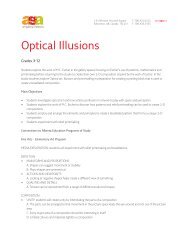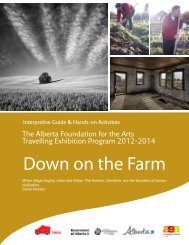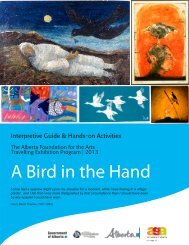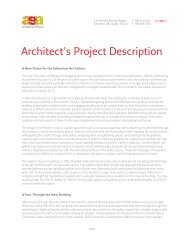Urban Animals - Art Gallery of Alberta
Urban Animals - Art Gallery of Alberta
Urban Animals - Art Gallery of Alberta
Create successful ePaper yourself
Turn your PDF publications into a flip-book with our unique Google optimized e-Paper software.
The <strong>Alberta</strong> Foundation for the <strong>Art</strong>s Travelling Exhibition Program<br />
Pop <strong>Art</strong>: A Brief Analysis<br />
Pop <strong>Art</strong> refers to an art movement that<br />
began in the mid 1950s in Britain and<br />
in the late 1950s in the United States.<br />
From the very start its imagery was<br />
largely based on American mass media<br />
and the movement thus had a special<br />
appeal to American artists. The Pop <strong>Art</strong><br />
Movement reached its fullest<br />
development in America in the 1960s.<br />
Pop <strong>Art</strong> challenged tradition by asserting<br />
that an artist’s use <strong>of</strong> the mass-produced<br />
visual commodities <strong>of</strong> popular culture is<br />
contiguous with the perspective <strong>of</strong> Fine<br />
<strong>Art</strong>. Pop <strong>Art</strong> is aimed to employ images<br />
<strong>of</strong> popular as opposed to elitist culture in<br />
art, emphasizing the banal or kitschy<br />
elements <strong>of</strong> any given culture. As such,<br />
pop art employs aspects <strong>of</strong> mass culture<br />
such as advertising, comic books, and<br />
mundane cultural objects as art subjects<br />
such as hamburgers and ice-cream<br />
cones. Pop <strong>Art</strong> is also associated with the<br />
artists’ use <strong>of</strong> mechanical means <strong>of</strong><br />
reproduction or rendering techniques<br />
such as the commercial advertising<br />
technique <strong>of</strong> silk-screening.<br />
Jasper Johns<br />
Flag, 1954-1955<br />
Museum <strong>of</strong> Modern <strong>Art</strong>, New York<br />
Patrick Caulfield<br />
Still Life with Dagger, 1963<br />
Tate <strong>Gallery</strong>, London U.K.<br />
In the United States Pop <strong>Art</strong> was initially regarded as<br />
a reaction to Abstract Expressionism because its<br />
exponents brought back figural, representational<br />
imagery and made use <strong>of</strong> hard-edged, quasiphotographic<br />
techniques. Early Pop artists, such as<br />
Jasper Johns, used the energetic brushstrokes and<br />
boldly abbreviated shapes <strong>of</strong> Action Painting, but Pop<br />
artists differed in that their paintings are about<br />
something beyond personal symbolism and<br />
‘painterly looseness’.<br />
Pop artists were <strong>of</strong>ten labeled Neo-Dadaists because<br />
they used commonplace subjects such as comic strips<br />
(Roy Lichtenstein), soup tins (Andy Warhol) and<br />
highway signs which had affinities with Marcel Duchamp’s ‘ready-mades’ <strong>of</strong> the early 20th<br />
century.<br />
<strong>Art</strong>ists associated with the Pop <strong>Art</strong> Movement are not unified in their artistic approaches but,<br />
AFA Travelling Exhibition Program, Edmonton, AB. Ph: 780.428.3830 Fax: 780.421.0479<br />
youraga.ca

















